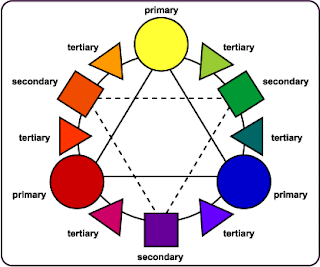 |
| Color Relationships Art |
 |
| Basic Color Schemes |
Westerberg started his class by offering a step-by-step how to paint demonstration of using two colors, terra rosa and Venetian red, to paint a portrait on white canvas. He first applied a thin wash of terra rosa to the canvas and set it aside to dry. “Once the toned surface is dry, I’ll use more terra rosa as a warm color for drawing the head, then use Venetian red as a cool color for darker values,” Westerberg explained. “Later, I will lift off some of the paint to expose the white canvas—the lightest value—and to establish what is called an ‘open grisaille.’ If I were to add titanium white to my palette and mix that with the two reds, I would wind up with a closed grisaille.
“You should start a painting by establishing the darkest darks, then go to the richest, most dominant color, and finally mark the lightest lights,” Westerberg continued. As his demonstration progressed, he finished the painting by laying in opaque color while still allowing the transparent colors of the underpainting to remain visible. He used a drybrush technique to establish transitions between thin and thick applications of oil color.



